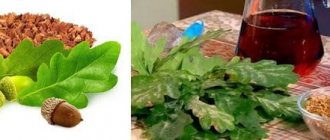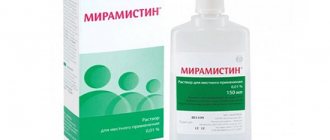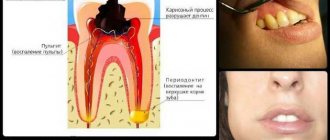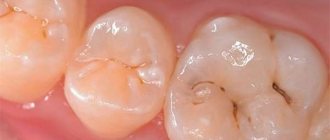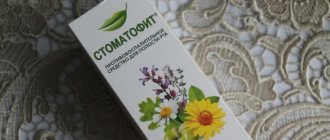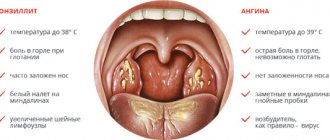Conservative treatment of chronic tonsillitis
Conservative therapy allows you to treat chronic tonsillitis at home. In case of chronic tonsillitis, it must solve several problems for patients in order to improve the quality of life of patients and at the same time preserve the tonsils in the body.
Sore throat with tonsillitis is a constant companion, and pain occurs in patients not only during relapses. Enlarged, hypertrophied tonsils make it impossible to eat normally and are irritated by hot or cold. In order to relieve low-grade inflammation, doctors prescribe drugs from the group of non-steroidal anti-inflammatory drugs. Patients are helped to get rid of unpleasant sensations in the throat by Ibuprofen, Nimesulide, Ibuklin and Paracetamol. The doctor will tell you how else to treat the pain.
Local therapy by rinsing the oral mucosa also plays an important role. Antihistamines help relieve exacerbation. Most topical treatments can be purchased ready-made at the pharmacy. They combine antiseptic, anti-inflammatory and softening effects. You can prepare similar rinses yourself by combining a little baking soda, salt and a few drops of iodine in a glass of warm water. These solutions can be used to gargle for chronic tonsillitis in children.
In order to combat chronic tonsillitis, sanitation of lacunae and removal of purulent plugs, dead leukocytes, and necrotic epithelium, which are contained inside these lacunae, are used. Such procedures help eliminate foci of chronic infection, so they should be performed as often as possible. For rinsing, you can use solutions from a syringe under pressure, or they can be devices with a special curved spout to get into hard-to-reach places. To achieve the desired effect, the procedure is carried out every day, the course of treatment is at least 12 days.
Unfortunately, the issue of using antibacterial drugs for chronic tonsillitis is still not resolved. Doctors were divided in opinion. Some believe that with a sluggish, latent course, antibiotics should not be prescribed; they only harm the body as a whole. Another group of doctors supports the idea that tonsillitis does not get worse just because a sore throat is controlled by antibacterial drugs. When treating patients, most specialists still carefully prescribe antibacterial therapy, reducing the amount of medications to a minimum.
Gargling and irrigating the throat with Miramistin can control the disease for a long time.
Traditional antibiotics are used - Sumamed, Azithromycin, Amoxiclav and Amoxicillin.
For gargling, ready-made solutions with an antimicrobial effect - Miramistin and Rotokan - are suitable, and you can also use decoctions and infusions of medicinal herbs. With the permission of a doctor, inhalations can be used. You can wash the lacunae as described above, and also treat chronic tonsillitis using the Tonzillor device. To do this, you must visit the clinic, since the procedure is performed only by qualified specialists.
You can also get rid of sluggish inflammation of the tonsils with the help of the drug Polyoxidonium. Today it is one of the most successful immunostimulants created by the pharmaceutical industry. It is included in the treatment of almost all inflammatory pathologies of the ENT organs. Polyoxidonium acts directly on the human immune system; it is able to increase the activity of killer cells that fight pathogenic microflora.
Over the years of observation of patients with chronic tonsillitis, it has been established that the drug Polyoxidonium is also capable of absorbing toxins that were formed during the course of the pathological process and removing them from the body. Chronic tonsillitis in adults and children can be treated in combination with other drugs, since Polyoxidonium is maximally tolerant of other medications.
Treatment of a chronic disease
Chronic tonsillitis occurs in two stages - remission and exacerbation. When carrying out treatment, it is necessary to perform procedures that will prolong the remission stage and protect against various complications.
Products for internal use
Use the following home remedies effectively:
- You can strengthen the body's defenses with the help of propolis-based products. For example, during the treatment of chronic tonsillitis, it is necessary to chew a small piece of propolis. You can do this procedure even at night, placing the product behind your cheek. But how pharyngitis is treated with propolis, and how to properly prepare the remedy, is described in the article.
In the photo - propolis for tonsillitis
- You can strengthen your immune system with onion juice. Combine it in equal proportions with honey. Take 3 times a day.
In the photo - onion juice
- Eliminate the symptoms of the disease and strengthen the immune system with the power of aloe juice. To do this, cut a leaf of the plant, squeeze out the juice and consume 10 ml every day for 10 days. After a month, the course can be repeated. But this information will help you understand how to use aloe juice for a runny nose.
In the photo - aloe juice for tonsillitis
- Garlic solution can be used to rinse the throat or for oral administration. You need to take 5 cloves of the vegetable, combine it with 40 g of sage and pour 1 liter of boiling water. Set the mixture on fire and simmer for 15 minutes. After 1 hour, filter and take 200 ml per day in 3 doses. You can also use a throat rinse. It will also be interesting to know how bronchitis is treated with garlic.
In the photo - garlic solution
Throat treatment
The throat can not only be gargled, but also lubricated with the following effective means:
- Take an aloe leaf and extract juice from it. Combine it with honey in a ratio of 1:3. Use the resulting mixture to treat tonsils. Conduct such events within 14 days.
- Squeeze the juice from the garlic cloves and mix it in equal quantities with water. Treat the tonsils with the mixture throughout the day. Perform similar actions every other day.
- Finely chop the herb St. John's wort in an amount of 100 g. Pour it with a glass of a mixture of the following oils: almonds, flax and olives. Leave the composition for 3 weeks, then filter and treat the tonsils 3 times a day.
Here you will find more information about the treatment of tonsillitis in adults.
Cold inhalation
This procedure is excellent for treating tonsillitis at home. To perform the manipulation you need to use only a few drops of ether and natural fabric. Drop oil onto it and inhale the healing aroma from it. You can perform cold inhalation without cloth. Just breathe over the bottle with ether for 5-10 minutes.
Cold inhalations can be carried out using an aroma lamp. Determine the dosage of oils according to your own feelings, but preferably add 3-7 drops of oil. Using an aroma lamp, the procedure lasts about 2-3 hours.
It is quite possible to treat tonsillitis at home, but only if the disease proceeds as usual and there is no deterioration. All recommendations for the procedure must be discussed with the attending physician. Well, that’s it, you can get the desired result provided that all manipulations are performed regularly.
How to treat tonsillitis
Treatment tactics for angina differ depending on its form. There are acute and chronic tonsillitis. The first occurs as a result of an infectious lesion and responds well to treatment. Chronic tonsillitis accompanies a person constantly, periods of remission alternate with exacerbations. Deterioration of the condition can be caused not only by infection, but also by simple hypothermia and weakened immunity. Treatment for angina is prescribed taking into account these features.
Acute tonsillitis
This type of sore throat responds well to therapy. Key points in the treatment of acute tonsillitis:
- Systemic therapy. Antibiotics are prescribed against a specific pathogen, or broad-spectrum if the tonsillitis is bacterial. If the sore throat is viral or fungal, the patient is recommended to take anti-inflammatory pills and immunostimulants.
- Local therapy. Helps get rid of tonsillitis symptoms faster. The patient is prescribed special mixtures for gargling and washing. Sprays for irrigation and lozenges with analgesic, antiseptic, and probiotic effects have proven themselves well. Preparations for topical use—sprays—have proven themselves to be effective in treating sore throats, and preparations of a complex composition are more effective. For example, the drug Anti-Angin Formula spray, which includes chlorhexidine, which has a bactericidal and bacteriostatic effect, and tetracaine, which has a local anesthetic effect.
The convenient spray form allows you to ensure the effect of the active components of the drug exactly where it is needed. Due to its complex composition, Anti-Angin has a triple effect: it helps fight bacteria, relieve pain and helps reduce inflammation and swelling.3Anti-Angin is presented in a wide range of dosage forms: compact spray, lozenges and lozenges.
Anti-Sore throat is indicated for manifestations of tonsillitis, pharyngitis and the initial stage of tonsillitis; this may be irritation, tightness, dryness or sore throat.
Anti-angina tablets do not contain sugar2*
*With caution in case of diabetes mellitus, it contains ascorbic acid.
Instructions for use of the drug Anti-Angin Formula in the dosage form of lozenges. Instructions for use of the drug Anti-Angin Formula in the dosage form of a dosed spray for topical use.
- Instructions for use of the drug Anti-Angin Formula in lozenge dosage form.
Instructions for use of the drug Anti-Angin Formula in the dosage form of lozenges.
- Instructions for use of the drug Anti-Angin Formula in the dosage form of a dosed spray for topical use.
- Physiotherapy. A set of measures aimed at destroying pathogens and suppressing symptoms.
There are contraindications. You need to read the instructions or consult a specialist.
How to treat chronic tonsillitis
This form of the disease, as a rule, develops if acute tonsillitis starts. The risk of its occurrence increases if treatment has not been completed completely. Chronic tonsillitis can be compensated or decompensated. In the first type, only the tonsils are affected, and in the second, other organs and tissues are also affected. If you have chronic tonsillitis, then the treatment for it is the same as for acute tonsillitis, but with some features:
- Antibiotics are prescribed after the pathogen has been determined by analysis, but the course of taking them is longer.
- Prevention of exacerbations is very important. It is necessary to lead a healthy lifestyle, avoid hypothermia, monitor nutrition and take all necessary measures to strengthen the body and protect it.
- It is recommended to drink immunostimulants and probiotics not during exacerbations, but for prevention during periods when the risk of infection is too high.
- Gargling with chronic tonsillitis is not always advisable, because purulent plugs appear in the lacunae, which are too tightly connected to the lymphoid tissue. Rinsing is more effective in this situation.
- Radical treatment is advisable. In this case, the tonsils are removed surgically or otherwise, which helps to minimize the frequency of exacerbations.
Differences between acute and chronic tonsillitis
Tonsillitis is an inflammatory disease that affects the tonsils (in most cases palatine) of the pharyngeal ring. The disease can be acute or become chronic.
The causative agents of both forms of tonsillitis are streptococcal bacteria, less often - viruses and fungi.
Important! If symptoms of acute tonsillitis are present, you should consult an otolaryngologist. Treatment with folk remedies can be used as an adjuvant therapy, but the main emphasis will be on treatment with antibacterial, antiviral or antifungal drugs, depending on the etiology of the disease.
With chronic tonsillitis, the tonsils cease to perform protective functions, but, on the contrary, are a “dormant” focus inhabited by infectious agents. They constantly poison the body with metabolic products - exo and endotoxins, under the influence of which toxic-allergic reactions begin in humans.
The influence of toxins in chronic tonsillitis can be expressed in increased fatigue, memory impairment, and absent-mindedness. More severe consequences are expressed in the occurrence of diseases of internal organs: psoriasis, lupus erythematosus, myopia, pneumonia; vascular, mental and endocrine disorders.
The tendency to develop chronic tonsillitis is increased in the following groups of people:
- with a deviated nasal septum;
- the presence of polyps growing from the paranasal sinuses;
- suffering from chronic sinusitis;
- having untreated lesions of caries in the mouth;
- regularly suffer from rhinitis, pharyngitis;
- having diseases that lead to decreased immunity.
If the disease has entered the stage of decompensation, that is, the lymphatic tissues are so changed that they can no longer perform their functions, the question of the need for tonsillectomy (removal of the tonsils) is raised. At the stage of compensation, when the tonsils partially prevent the development of the disease, treatment with folk remedies is advisable.
Bacterial
Therapy for this type of disease consists of the following stages:
- A bacterial infection requires an antibiotic. The doctor may prescribe penicillin, since it is the most popular antimicrobial drug. You must drink it within 10 days, even if the symptoms of the disease disappear. An incomplete course of antibiotics can lead to a deterioration in health, and the infection can switch to other organs.
- Taking medications to reduce sore throat. For example, ibuprofen not only relieves discomfort, but also reduces fever. It is better to start taking such medications after receiving permission from your doctor.
- Rinsing. The simplest solution can be prepared at home. To do this, you need a glass of warm water and a teaspoon of salt.
- Special food. Frequent warm drinks and soft foods will help reduce sore throat.
- Peace. In the first days of the disease, the patient is advised to stay in bed and keep conversations to a minimum.
- Eliminating irritants. Since the patient’s throat is dry, it is necessary to monitor the optimal humidity in the room. It should be above 50%. There should be no cigarette smoke or smell of cleaning products entering the patient's room.
Chronic tonsillitis - definition of the disease
Chronic tonsillitis is a frequent inflammation of the tonsils. Treatment for this disease until recently consisted of removing the tonsils, since a constantly existing source of infection caused severe complications and was difficult to treat.
Today, effective non-surgical methods for treating tonsillitis have been developed, allowing one to achieve good results in a short time. In addition, doctors recommend supplementing drug treatment with folk remedies at home in order to have a comprehensive effect on inflammation.
Tonsillitis as an immune reaction
Tonsillitis occurs primarily in children and adolescents as their immune system continues to develop to protect the body from foreign substances that have entered the body.
Pathogenic bacteria, viruses and fungi, and other microorganisms are carriers of a foreign protein that is recognized by the immune system. With tonsillitis, the immune system is weakened, which is why the disease manifests itself.
What is immunity
The human body is a symbiont. We cannot exist without interacting with microorganisms. Bacteria live in the intestines, on the mucous membranes of the nasopharynx, they are found in the trachea and bronchi, and on the skin.
This is a non-pathogenic microflora, for example, without lactic acid bacteria in the intestines it is impossible to digest food and produce some vitamins. The human immune system “allows” such microflora to exist without considering it foreign.
Levels of the immune system
Table. Human immune system:
| Levels of protection | Function performed |
| Cellular immunity | T-lymphocytes produced in the thymus are carried by blood to all organs, recognize foreign proteins, and destroy them. |
| Humoral immunity | Humoral means body fluids, blood, lymph, interstitial fluid. In body fluids, B lymphocytes produce antibodies, immunoglobulins, which are harmful to microbes and viruses. |
| Phagocytosis | In the blood there are macrophages-monocytes, neutrophils that attack and digest foreign proteins. Macrophages destroy cells infected with viruses. |
The immune system is also complex because the body’s own proteins that have lost their functionality must be destroyed. In order not to “eat” healthy cells and proteins, the body has created a complex chemical system for recognizing “friend or foe”.
This is also a function of the immune system. When someone tells how I cured chronic tonsillitis, you need to understand that the person simply strengthened his immunity.
How to strengthen your immune system
How to cure chronic tonsillitis once and for all by strengthening the immune system? This is a very difficult task. How to strengthen individual cells, phagocytes and lymphocytes, and make their functions more effective?
The immune system is not a separate organ that can be treated, like diseased lungs or tonsils. How long to treat chronic tonsillitis depends on your overall health.
Still, there are means that, when used, can increase the body’s ability to recognize and destroy pathogenic bacteria and viruses.
Methods that increase the body's protective capabilities:
- organization of a rational circadian rhythm, combining work and rest, adequate sleep;
- eating nourishing and healthy foods rich in dietary fiber and vitamins;
- the use of healing procedures: hardening and contrast showers;
- measures to prevent stressful situations;
- taking interferons and immunoglobulins;
- use of probiotics, biologically active food additives;
- immunomodulatory drug: Likopid, Amiksin, Immunorix, Ribomunil, Imudon, IRS-19, Levamisole, Cycloferon;
- the use of antioxidants and vitamin complexes;
- consumption of honey, propolis (see), rosehip infusion.
After measures to strengthen the immune system due to the general health of the body have shown their effectiveness, you can begin to answer the question of how to cure chronic tonsillitis.
Prevention of chronic tonsillitis
Considering that the treatment of this pathology is somewhat difficult, it is necessary to make every effort to prevent the development of the disease.
Prevention of chronic tonsillitis involves monitoring so that there are no obstacles to the passage of air when breathing through the child’s nose.
It is imperative to promptly treat throat infections.
It is especially important to understand how to cure chronic sore throat. This disease can create favorable conditions for tonsillitis.
After a sore throat, preventive rinsing of the lacunae should be carried out. Lubricating the tonsils with medications recommended by your doctor for inflammation of the mucous membranes of the larynx will help reduce the risk of developing chronic tonsillitis.
For this purpose, iodine-glycerin is often used - 1%, etc. As part of the prevention of chronic tonsillitis, it is necessary to practice hardening throughout the year.
This will increase the activity of the immune system and will prevent inflammation due to infectious damage to the tonsil tissue. Water and other drinks are best consumed warm.
The basis of the diet should be foods high in plant fiber, vitamins and minerals.
A strong immune system is a shield against infection.
Complications of chronic tonsillitis
As mentioned earlier, chronic tonsillitis is one of the main causes of tonsillitis. If no effective measures are taken, the disease can cause damage not only to the larynx, but also to almost all internal organs. If chronic tonsillitis is treated with antibiotics for a long time, a disease such as dysbiosis can be caused. In addition, kidney failure and diabetes may begin to develop.
Chronic tonsillitis can cause the development of a cancerous tumor, which means only one thing: it is important to consult a doctor in a timely manner. It is necessary to treat the sick person in every possible way so that you do not have to operate on the larynx and remove tonsils or a developed cancerous tumor.
We cannot allow a person’s inattention to his own health to result in great grief for him.
However, some doctors still believe that tonsils cease to perform their function after 25 years. Therefore, they are not afraid to immediately schedule an operation to remove them. You should not agree; the patient has the right to consult with several doctors, listening to their informed opinion, which, most likely, will have a lot of contradictions. Therefore, the patient will have to make a decision on what methods and how to cure chronic tonsillitis independently.
But while the decision is being considered and made, the disease progresses, causing exacerbations of more and more attacks of sore throat. It is noted that chronic tonsillitis often causes damage to the cardiovascular system. What does this mean? It's not hard to guess. This is another reason to see a doctor as soon as possible for help. It is always difficult to realize the seriousness of the disease, especially since in the early stages it is difficult to diagnose this disease and it may not be recognized. But a sore throat and inflammation of the tonsils are unlikely to let you forget about yourself. By accepting the idea that treatment is necessary, a person solves many problems for himself.
How tonsils work
Tonsillitis is a disease of an infectious-allergic nature that affects one of the organs of the immune system - the palatine tonsils. They are located on both sides of the pharynx; inhaled air and swallowed food pass by them. The task of the tonsils is to retain viruses and bacteria so that they do not enter further into the body. For this purpose, on their surface there are many depressions and channels - lacunae and crypts, in which the infection lingers. Next, lymphocytes are involved in the work. They attack “uninvited” guests and destroy them. Dead cells and decay products are washed away with saliva, without causing any harm to the person. This process occurs if a person has a strong immune system.
During outbreaks of infectious diseases, the tonsils have more “work”; they often cannot cope with the “influx” of infection. A similar picture develops when the body’s defenses decrease. Tonsillitis as a disease occurs as a result of hypothermia, the presence of chronic diseases, and untreated sore throat. Then the tonsils themselves become a constant source of infection. Dead leukocytes and microbes accumulate inside the tonsil, forming purulent masses. They irritate tissues and cause inflammation. Under favorable conditions, the chronic form quickly turns into acute. Therefore, frequent sore throats are considered one of the signs of the disease.
A negative consequence of chronic tonsillitis is a gradual change in the structure of the tonsils. Lymphoid tissue is gradually replaced by connective tissue. It has a coarser structure, so the mouths of the lacunae and crypts narrow, and the drainage function is disrupted. The contents of the glands stagnate in them, promoting the active development of microbes.
Symptoms of tonsillitis
The main signs by which chronic tonsillitis can be diagnosed are:
- discomfort when swallowing,
- swelling of the tonsils and nasopharynx,
- painful reaction to cold or spicy food,
- bad breath.
A person complains of a constant sore throat, and the severity of its manifestation may vary. A constant slight increase in body temperature above 37 degrees is also possible. The tonsils are slightly enlarged and inflamed. In the acute stage they become bright red, in the chronic stage they become dark red. You can notice plaque and small pustules on them.
You will not be able to distinguish tonsillitis from diphtheria on your own.
Additionally, signs of intoxication are observed: fatigue, lethargy, weakness. An adult's performance decreases; the child also feels constant weakness and becomes inattentive. Such symptoms are characteristic of the development of tonsillitis and pharyngitis, so to establish an accurate diagnosis you need to consult an otolaryngologist. If treatment for chronic tonsillitis is not started, then over time it causes complications in the joints, heart, and kidneys.
Diagnostics
To diagnose tonsillitis, the doctor interviews the patient, finding out the history of the disease. He needs to know how often and what the person was sick with. An examination of the nasopharynx (pharyngoscopy) is also carried out, which allows you to assess the condition of the tonsils - size, shape, color, presence of plaque and pustules. The surface of the tonsils looks loose, scars may appear, the edges of the palatine arches thicken, they are hyperemic, and the lymph nodes become enlarged.
If necessary, tests are prescribed. A general blood test can establish signs of infection in the body: the number of leukocytes increases, the ESR increases. A throat swab helps determine the type of pathogen.
Reasons why the disease develops
Most often, chronic tonsillitis occurs after a case of [acute form of the disease (angina)].
As already mentioned, in childhood the process becomes more chronic. This occurs due to the immaturity of the body’s immunological forces.
The direct cause of the disease is bacterial infectious agents, the most common are streptococci and staphylococci, and the least common are meningococci, chlamydial infection, and mycoplasma.
Lymphoid formations play a protective role when the body encounters various infections. As soon as the pathogen enters the mucous membranes of the lymphoid formations, a series of immune reactions are launched aimed at destroying the pathogen.
Antibodies and a number of immunoactive substances are produced.
With frequent infections or massive infection, the lymphoid formations cannot cope with the load, and an inflammatory focus forms in the thickness of the tonsil.
Important to know: Which inhalations to use for tonsillitis
An accumulation of bacteria develops in the thickness of the organ. A number of factors contribute to this process:
- cooling the body;
- respiratory infectious diseases;
- untreated cases of tonsillitis;
- chronic foci of infection in the human body;
- hypovitaminosis;
- leading an unhealthy lifestyle;
- poor nutrition;
- alcohol consumption;
- smoking;
- lack of sports activities.
Treatment for chronic tonsillitis must be carried out promptly and efficiently, as the disease can lead to serious complications.
Treating tonsillitis at home
You can use drug therapy on your own. Treatment of tonsillitis at home should be carried out exclusively with the drugs prescribed by the doctor. Be sure to follow all his recommendations and go to appointments regularly. The doctor must monitor the dynamics and, if necessary, change tactics and prescriptions. As a rule, antibacterial drugs, anti-inflammatory and antihistamines, rinses, and inhalations are prescribed.
Antibiotics for tonsillitis
Such medications are prescribed only by a doctor. He may prescribe an antibiotic for tonsillitis based on the type of pathogen or recommend a broad-spectrum drug. The latter are prescribed more often. Penicillin antibiotics are good for tonsillitis. In most cases, the following medications from this group are prescribed for angina:
- Flemoxin;
- Ceftriaxone;
- Ampiox;
- Flemoclav;
- Amoxicillin;
- Cefixin;
- Amoxiclav;
- Augmentin;
- Unazine;
- Cefepime;
- Oxacillin;
- Ampicillin;
- Ampiside;
- Panclave.
Penicillin antibiotics may not be effective if you are infected with a strain of bacteria that is resistant to them. In this situation, it is recommended to take macrolides. Such medications act more gently on the stomach and kill the infection faster. They have fewer contraindications and do not suppress the immune system. Macrolides and cephalosporins prescribed for tonsillitis:
- Azithromycin (Sumamed);
- Roxithromycin;
- Josamine;
- Macropen;
- Erythromycin;
- Clarithromycin.
If the causative agent of tonsillitis is Staphylococcus aureus, aminoglycosides are prescribed. This group includes:
- Amikacin;
- Norfloxacin;
- Levoflocacin;
- Zanotsin;
- Ofloxacin;
- Ciprofloxacin;
- Xenaquin;
- Kirol.
Medicines for sore throat
To alleviate the general condition and quickly eliminate the symptoms of tonsillitis, anti-inflammatory and antihistamines are used. These are tablets, sprays, lozenges, ointments. The most common medications for tonsillitis:
- Tantum Verde. Anti-inflammatory medicine (tablets, spray, solution). Promotes rapid restoration of the mucous membranes of the tonsils. Allowed for children from the age of six.
- Faringosept. Antiseptic. Lozenges for resorption. Use is permitted from three years of age. Not contraindicated for pregnant and lactating women.
- Remantadine. Anti-inflammatory drug.
- Falimint. Antiseptic with analgesic effect. Prohibited for children under five years of age, pregnant women, lactating women and those who have an allergic reaction to the components of the product.
- Tonsilotren. Homeopathy drug, immunomodulatory and anti-inflammatory. Allowed for children from one year old.
- Tonsilgon. Herbal preparation in drops and tablets. Antiseptic, relieves inflammation. Drops can be taken even by infants, and tablets can only be taken by children over six.
- Imudon. Immunostimulant. Prohibited for children under three, nursing, and pregnant women.
- Ambassador Antimicrobial and anti-inflammatory medicine.
- Strepfen. Anti-inflammatory drug. Effectively eliminates sore throat.
How to gargle for tonsillitis
Local treatment at home plays a very important role and will bring you significantly closer to recovery. Gargling for tonsillitis helps kill bacteria that are constantly present in the lacunae of the tonsils and destroy their waste products. In addition, rinses relieve sore throats and tighten wounds. This speeds up the healing process. The following solutions are very effective for rinsing:
- Chlorophyllipt;
- Hexoral;
- Chlorhexidine;
- Furacilin;
- Bicarmint;
- Iodinol;
- Lugol.
Inhalations for sore throat
A very effective type of local therapy. Inhalations for tonsillitis have the following effect:
- They help the medicinal composition to quickly and evenly distribute throughout the mucous membrane.
- Relieves inflammation.
- Fighting infection.
- Relieves pain and soreness.
- Liquefies mucus.
Folk remedies and the following medications are used for inhalation:
- Chlorophyllipt;
- Furacilin;
- Miramistin;
- Dekasan;
- Chlorhexidine;
- Dioxin;
- Dexamethasone;
- Pulmicort.
Complications
Streptococcal infection (which is mainly tonsillitis) is dangerous due to complications. The most common of them are post-treptococcal endocarditis and glomerulonephritis.
The following complications of tonsillitis are common:
- acute rheumatic fever;
- poststreptococcal endocarditis;
- poststreptococcal glomerulonephritis.
Diseases associated with chronic tonsillitis also include:
- collagenoses (systemic lupus erythematosus (SLE), dermatomyositis, scleroderma, periarteritis nodosa);
- thyrotoxicosis;
- skin diseases (polymorphous exudative erythema, eczema, psoriasis);
- diseases of peripheral nerves (radiculitis, plexitis);
- thrombocytopenic purpura;
- hemorrhagic vasculitis.
Features of the disease
Tonsillitis is an infectious disease, the symptom of which is inflammation of the tonsils.
When a bacterial infection enters the human body, an inflammatory process begins to develop in the tonsil area. This causes inhibition of the process of developing immunity, and the result is the appearance of tonsillitis. In some cases, problems with the formation of the body's protective functions can arise when the treatment is not carried out correctly, as well as when taking antipyretic drugs at a not very high temperature.
In some cases, the development of tonsillitis is caused by various problems with nasal breathing that arise from the following pathologies:
- adenoids in childhood
- polyps in the nasal cavity
- deviated nasal septum
Often the cause of local tonsillitis is foci of infection localized in nearby organs.
Pathology can develop in the presence of sinusitis or chronic adenoiditis.
Not the least role in the course of chronic tonsillitis belongs to a decrease in the protective functions of the body, namely allergic reactions. This means that they can be both the cause of the development of the disease and just a consequence of a chronic disease.
Acute tonsillitis is characterized by a pronounced onset with a syndrome of general intoxication of the body:
- body temperature rises to 40 degrees
- increased sweating
- severe weakness of the whole body
- decreased or complete lack of appetite
- pain and aches in muscles and joints
- development of chills
Simultaneously with these symptoms or after some time, the patient begins to feel pain in the throat, which gradually intensifies. Over time, the pain becomes so severe that the patient cannot swallow anything, and sleep problems arise. The reaction of the lymphatic system to the inflammatory process in the throat is an enlargement of the lymph nodes and their increased soreness.
Chronic tonsillitis is characterized by periods of remission followed by exacerbation of the disease. The most characteristic symptoms of such tonsillitis are a slight rise in body temperature, discomfort in the throat when swallowing and a slight cough. The diagnosis at this stage of the disease is made based on the results of a visual examination of the patient’s throat.
Against the background of respiratory viral diseases that occur when the protective functions of the human body decrease, the remission stage is replaced by an exacerbation:
- body temperature rises to 39 degrees
- there is a feeling of a foreign body in the throat, discomfort and pain
- symptoms of body intoxication appear
- the secretion released from the tonsils causes the patient to constantly cough
is accompanied by the appearance of vivid symptoms, so it is quite difficult to miss it. If such signs occur, you should contact a specialist who will examine the patient and select the most effective treatment.
Symptoms of tonsillitis
After the infection enters the body, it can take from 12 to 48 hours, then the first symptoms appear in the form of a sensation of a lump in the throat. Subsequently, pain appears, which gradually intensifies and begins to radiate to the ears. The mucous membrane of the throat becomes red and swollen, causing the tonsils to significantly increase in size.
With tonsillitis, redness and swelling of the mucous membrane of the throat and tonsils occurs, and an abscess may develop
The pain of a sore throat can be so severe that a person cannot eat. Regional lymph nodes enlarge, which become an obstacle to infection.
Upon visual examination, purulent plugs can be detected on the tonsils or in lacunae. Bad breath may appear. Body temperature rises to high levels (38–39 °C), headache, muscle pain, weakness, and drowsiness occur.
In order to eliminate intoxication, you should drink plenty of fluids. For these purposes, tea with lemon, juice, fruit drink, alkaline mineral water or dried fruit compote are suitable. Drinks should not be cold.
If the disease is not treated in time, it will develop into a chronic abscess and may periodically worsen, causing symptoms of acute tonsillitis.
Non-standard methods of treating tonsillitis
Sometimes you can find the most incredible recommendations from people who are trying to cope with tonsillitis.
Ice cream treatment. Ice cream for sore throat can be used as an aid. Instead of ice cream, they also use fruit ice cubes, which are recommended for patients of different ages to dissolve several times a day.
What benefits can cold ice cream bring to a sore throat? This product acts as a local analgesic. A cold treat, touching the throat, constricts blood vessels - this helps reduce inflammation and speed up recovery. You can give ice cream to a person with a sore throat only in a warm place and no more than 100 grams at a time.
Treatment with vinegar. Apple cider vinegar helps with sore throat. A teaspoon of vinegar is dissolved in a glass of warm water. This solution not only rinses the throat, but also drinks it in small volumes. This allows you to clean the back wall, which the solution simply does not reach when rinsing. If the sore throat is not advanced, then with this treatment the disease disappears without a trace in three days. Treatment with beer and wine. There are adherents of treating tonsillitis with alcoholic beverages - hot beer and wine.
Beer actually contains useful substances that have a vasodilating and analgesic effect. The same can be said about red wine. But it is worth remembering that alcohol, and especially hot alcohol, should absolutely not be consumed at high temperatures.
Goose or beaver fat. It may seem strange, but such a mixture gives an excellent effect in the treatment of tonsillitis - a glass of hot milk, a teaspoon of honey, a small crushed clove of garlic and a teaspoon of goose or beaver fat. The taste is quite unpleasant, but quickly relieves the disease.
Compress with lard. Fresh lard is cut as thin as possible, the pieces are placed on the throat, and covered with parchment paper on top. Next comes a layer of cotton wool, cellophane and a wool scarf. This compress is done at night; in most cases, one procedure is enough to get rid of pain. Compress with salt. A wide bandage is folded into 5-6 layers, moistened in a warm 10% solution of table salt and placed on the neck. A layer of cellophane and cotton fabric are placed on top in several layers. Having done one such procedure at night, you can forget about the pain.
Sore throat is such an unpleasant disease that people try to get rid of it by any means. Treatment of this disease must begin with a visit to the doctor, who will tell you how to properly treat it so that there are no complications.
In an adult
Gargling and nasopharynx are considered the most effective. For this, a variety of decoctions and substances are used; some traditional and not quite ordinary rinses are discussed later in our article. All of the methods listed below work well for tonsillitis. If you have a different disease, then you need different prescriptions. Here you can read how to quickly cure a sore throat with folk remedies. And here we describe the treatment of pharyngitis with folk remedies in adults.
Some simple gargling options:
- Lemon juice, always diluted with warm water.
- Pharmacy tincture of calendula: 2–3 tsp per glass of water is enough.
- Chamomile decoction, prepared according to the instructions on the package.
- Horseradish juice diluted with water.
- Basil oil or decoction.
- A weak solution of potassium permanganate, to which add a couple of drops of iodine.
The good thing about such products is that they can serve in emergency situations, because most of the ingredients are quite accessible and can be found in every home. If you approach the problem even more seriously, it is better to get a pharmacy collection of herbs (or stock up on them yourself). The big advantage of these decoctions is their low cost coupled with high efficiency. You need to alternate the means, choosing the most suitable one for you.
In the video, treatment of tonsillitis with folk remedies:
Herbal gargles:
- Calamus root, burnet, chamomile. Take in equal proportions, boil or brew in a water bath, then strain and use warm.
- Thyme, chamomile, St. John's wort, eucalyptus and sage. Also take in equal quantities. Take 1 tbsp per glass of boiling water. l. dry mixture. Boil everything and let it sit for a while, then strain and you can rinse.
- Calamus root, nettle, St. John's wort, string, lingonberry leaves and horsetail. Mix everything and use 2 tbsp. l. half a liter of boiling water.
- Fresh potato flowers: a handful of inflorescences per glass of boiling water.
- Pour about 300 ml of boiling water over five cloves (spice) and leave to steep in a thermos for at least two hours.
Potatoes are often used to treat the throat. By following the link, for example, you can read how to breathe properly over potatoes. Along with rinsing and ingesting herbal preparations, there are also somewhat non-trivial methods for treating tonsillitis at home. Your doctor can give you the best recommendations, but the following original methods will help ease your symptoms and speed up your recovery.
Read how to make a soda solution for gargling.
Recipe and reviews for using figs with milk for coughs: .
Here you can familiarize yourself with the symptoms of atrophic rhinitis.
Unconventional methods
- Gargling with warm champagne. What the secret is to medicine is not known for certain, but the result will be good.
- During the day, rinse with the original solution . The peculiarity is that three glasses of the prepared solution are used for this. The first one will be with warm water and a teaspoon of soda. The second portion is made with saline solution and a little colder. The third glass is taken with water at room temperature, to which 30 drops of regular iodine are added. The course must be repeated 4-5 times a day until the sore throat disappears completely.
- Brew St. John's wort branches along with inflorescences in 0.5 liters of boiling water, 1 tbsp. l. take orally instead of tea as often as possible, but no more than 5 times a day.
- Gently rubbing the affected areas of the tonsils with purified kerosene . A rather controversial method of treatment, more suitable for extreme situations.
- Cover the chopped onion with sugar until the juice appears . Take 1 tsp three times a day, and it is recommended even for pregnant and nursing mothers.
- a small piece of propolis in your mouth until it disappears completely. Repeat twice a day until recovery.
- Throw turmeric and black pepper onto a glass of hot milk on the tip of a knife. Drink at night until symptoms and sore throat disappear.
Tonsillitis symptoms and treatment at home
Tonsillitis most often occurs in spring and autumn. Those at risk include people who smoke, eat poorly, or work in hazardous industries. This disease is transmitted by airborne droplets and attaches most strongly to those with weakened immune systems. Acute tonsillitis or sore throat begins with a sore throat, high fever and weakness. If a person often gets a sore throat, it means he has chronic tonsillitis.
Many people know the symptoms of tonsillitis, and treatment at home is carried out using hot compresses to warm the neck from the outside. The throat is treated from the inside by gargling. The solution can be made from water, soda and salt. Some people use water and horseradish juice, which is diluted in a 1:1 ratio. Some gargle with warm champagne, the procedure is carried out every hour. In twelve hours there will be no trace of a sore throat.
Someone gargles with a decoction of herbs. Herbs such as chamomile, sage or calendula are suitable. The main thing is that the solution is neither cold nor hot, otherwise you can get the opposite effect. All solutions and decoctions should be warm and not burn the throat.
Chronic tonsillitis treatment at home
Frequent sore throats lead to tonsillitis becoming chronic. At risk are people who suffer from constant nasal breathing problems and those who have caries on their teeth.
Treatment at home for chronic tonsillitis is carried out using heating and rinsing, you can also lubricate the sore throat with Lugol's solution. If your throat is sore and sore, there is bad breath and pain, you should immediately start gargling. After gargling, you can spray your throat with a spray. Chronic tonsillitis is dangerous because it has a number of complications, such as diseases of blood vessels, heart, skin, joints and kidneys.
If the tonsils are constantly inflamed, you need to squeeze the juice from the coltsfoot and onion, add red wine and water in equal proportions. Take one tablespoon three times a day. Keep refrigerated.
A solution made from boiled water, soda, salt and iodine is well suited for rinsing. For a glass of water you need to take half a teaspoon of soda, the same amount of salt and a few drops of iodine.
For chronic tonsillitis, it is recommended to lubricate the tonsils daily with aloe juice and honey. The course is two weeks.
Bacterial tonsillitis treatment at home
The tonsils are located on either side of the back of the throat. They help protect the body from pathogens that enter the mouth. Most often, tonsillitis occurs due to group A streptococci. Tonsillitis is transmitted in the same way as influenza, by airborne droplets.
Treatment of bacterial tonsillitis at home is carried out using antibiotics of the penicillin group. If a person is allergic to penicillin, they can be treated with erythromycin. Oral antibiotics are treated for two weeks, no longer. The main disadvantage of antibiotic treatment is diarrhea and rash, which not everyone gets. The main thing is to get rid of bacteria, and the microflora can then be restored. After all, advanced tonsillitis leads to serious complications that are even more difficult and longer to treat.
During illness, you should not smoke, you must monitor the air humidity in the room, and also constantly gargle.
Acute tonsillitis
Sore throat or acute tonsillitis is an infectious disease that affects the lymphatic pharyngeal ring. This disease is caused by staphylococci and streptococci. Sore throat can be ulcerative-membranous, catarrhal, herpetic, lacunar, phlegmonous, follicular and fibrinous.
Catarrhal sore throat develops quickly, a person experiences a burning sensation in the throat, dryness and pain when swallowing. The temperature is usually low-grade. With proper treatment, acute tonsillitis resolves within five days.
Follicular tonsillitis begins with a high temperature. There is a pain in the throat that radiates to the ear. The lymph nodes are enlarged, in some even the spleen is enlarged.
Folk remedies
If chronic tonsillitis is detected in an adult or child, in addition to medications, the use of folk remedies will be no less effective. Herbal infusions are considered the most affordable and easiest to use at home.
We recommend reading: Benefits and contraindications of home nasal rinsing with folk remedies
Phytotherapy
In the treatment of tonsillitis, there are many proven recipes that have a positive effect.
- Herbal collection with antibacterial and anti-inflammatory effects. To prepare it you will need: St. John's wort, calamus root, calendula flowers, coltsfoot, wormwood, black currant leaves, eucalyptus, dill, thyme, chamomile flowers, sage, peony root. The same amount of each component is needed. Take one teaspoon of the resulting mixture and fill it with water, the temperature of which should be about 18-25 degrees. Then let it brew for four hours. Then the infusion must be boiled over fire for 2 minutes and strained. It is recommended to take the medicine half a glass twice a day;
- Antiseptic collection. Grams are used for calculations. You will need: calendula flower – 15; chamomile – 10; licorice root – 10; wild rosemary – 10; elecampane root – 10; sage – 15; eucalyptus – 20. Pour a tablespoon of the resulting mixture with a glass of water and boil for about 5 minutes. After this, let it brew for 6 hours. The infusion can be taken internally, 1 tbsp. l. 3 times a day, and use for rinsing.
You can also make an immunostimulating collection:
| Plant name | Quantity, gram |
| Volodushka | 20 |
| horsetail | 10 |
| St. John's wort | 15 |
| ephedra | 5 |
| marsh wild rosemary | 15 |
| dog-rose fruit | 25 |
| liquorice root | 5 |
| Leuzea | 15 |
| calamus | 25 |
| evading peony | 20 |
The resulting composition is also poured into a glass of water, put on fire and boiled for ten minutes. You need to insist for at least one hour.
The strained broth is taken fifty milliliters at least six times. You can add honey for taste.
Propolis
First of all, propolis must be crushed and mixed with an alcohol composition. In this case, the proportions are taken 1:1.
Everything is covered with a lid and sent to a dark place for infusion for 5 days. It is recommended to take the resulting tincture 20 drops three times a day. You need to drink it with water.
The duration of treatment is two weeks. Then you need to take a break for seven days. The course must be repeated three times.
Garlic
To make garlic drops, you will need five cloves of garlic. First, it is crushed and mixed with two teaspoons of vegetable oil. After this, close tightly and put away for five days.
The infusion is filtered. Don't forget to add a couple of drops of lemon juice. It is important not to forget to stir it before use.
We recommend reading: How to get rid of a dry cough attack at home
The medicine is taken after waking up and before going to bed. The dosage is 10 drops.
Myrtle leaves and St. John's wort
There are several recipes using these plants.
- Myrtle tincture. The crushed leaves are taken in the amount of half a glass and filled with 200 milliliters of alcohol. The mixture must be infused for about 7 days in a tightly closed container. To rinse, add 1 spoon of the resulting tincture to a glass of warm, but not hot, water. The duration of the procedure should last at least a month;
- Myrtle decoction. To prepare, you need to pour 10 myrtle leaves with 250 milliliters of water. The mixture is boiled over a fire for 5 minutes and infused for 20 minutes. Be sure to remember to strain. The medicine can be taken orally, one tablespoon 2 times, or gargle with it. The course of treatment is thirty days;
- St. John's wort oil. It is considered one of the best antibacterial agents. Crushed flowers and leaves of the plant are mixed with odorless vegetable oil. At 3 tbsp. spoons of the mixture will need a glass of oil. After this, put it in a dark place for 25 days. After the required time has passed, the mixture is filtered and then stored in the dark. The finished oil is used as a lubricant for the tonsils. The procedure is carried out in the morning, lunchtime and evening.
Beetroot and cloves
- Five carnation flowers are steamed with ¼ cup of boiled water. The decoction is infused for two hours. Three doses of 50 grams are prescribed. The course lasts 20 days. It is recommended to repeat twice a year;
- Beet juice. The recipe is quite simple. You just need to grate the vegetable and squeeze out the juice from the resulting mass. The dosage is 1 teaspoon three times a day. This treatment must be continued for 14 days;
- Beetroot broth. Unpeeled beets are grated on a coarse grater. Next, add a liter of water and cook for an hour. After this it is cooled and filtered. The decoction is intended for gargling several times a day. The procedure is carried out exclusively after eating food.
Inhalations
The essence of the method is to breathe over a pan of hot broth.
Inhalations are an effective remedy in the fight against inflammation of the tonsils. However, it is important to remember that this procedure can be carried out at home only if the patient does not have a high fever.
Chamomile, eucalyptus and string are well suited for using such inhalations. You can also use chlorhexidine, essential oils that have an antiseptic effect and soda.
We recommend reading: Treatment of cough in children and adults with folk remedies
Bee products
Everyone knows that bee honey is the most unique product, which is not only tasty, but also has many beneficial properties. That is why it is so popular in the treatment of many diseases, including tonsillitis, not only in adults, but also in children.
A number of recipes can be used for honey therapy:
- Melt 20 grams of butter in a water bath. A spoonful of honey and a small pinch of soda are added to it. Everything is thoroughly mixed and stored in the refrigerator. The dose is 1 teaspoon three times a day;
- Onion juice, aloe and honey are mixed in equal quantities. The dosage is the same as in the first recipe.
Diagnosis and medications for the treatment of tonsillitis in adults.
Adenoids in children, how to cure without surgery?
Drugs for the treatment of acute bronchitis.
